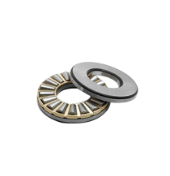What are Tapered Roller Bearings?
Taper Roller Bearings have a cup, cone and rollers which are tapered in shape. Rollers are restrained by a flange on the cone against which their large end slides. These bearings can take combined loads (radial and axial) simultaneously. Projection lines of the cup and cone raceways and rollers meet at a common point on the bearing axis.
The axial load carrying capacity of bearings increases with the increasing contact angle. Bearings are separable so a cup can be separated from cone assembly. Hence both can be mounted separately. The raceway and rollers have crown profiles. Improved surface finish of flange enables cooler running by forming a full lubrication film with the roller head.
Types of Tapered Roller Bearings

Four-Row Tapered Roller Bearings

Single-Row Tapered Roller Bearings

Tapered Roller Thrust Bearings

Double-Row Tapered Roller Bearings
Features of Tapered Roller Bearings
Depending upon the application requirements taper roller bearings can come in different variants such as double row, four row, etc. The primary features of taper roller bearings are:
- This variant of roller bearings can be customized to match specific speed, weight, temperature, etc.
- The cup is made of the outer ring of the bearing and cone assembly includes inner ring, rollers and cage.
- The design effectively helps combine two bearings for a higher impact on productivity.
- The separable components ensure a safe mounting and unmounting.
- Works well in high speed and high temperature applications.
Advantages of Tapered Roller Bearings
- A rigid bearing application can be achieved by combining two tapered roller bearings and applying a preload making these highly customisable.
- Amps up performance, reduces friction as well as increases power density simultaneously in applications.
- The raceways make for smooth operations in high speed operations leading to low friction, less noise and vibration.
- It has tenacity to function even under difficult circumstances ensuring minimal downtime.
- Manages heat well and works for a longer service time.
- Low maintenance ensures that the resources are utilised for longer periods of time.

